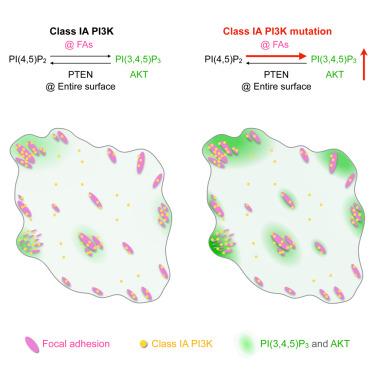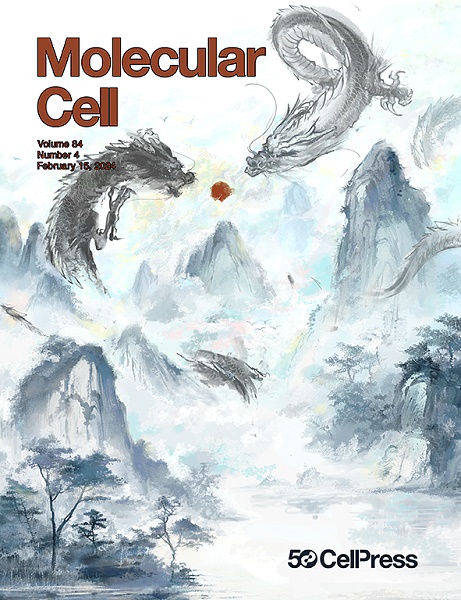病灶粘连对 PI3K-PI(3,4,5)P3-AKT 信号传导的空间组织作用
IF 14.5
1区 生物学
Q1 BIOCHEMISTRY & MOLECULAR BIOLOGY
引用次数: 0
摘要
I 类磷脂酰肌醇 3- 激酶(PI3K)-AKT 信号通路是细胞存活、生长和增殖的关键调节因子,也是癌症中最常发生突变的通路之一。然而,人们对哺乳动物细胞中 PI3K-AKT 信号在何处以及如何在空间上被激活和组织仍然知之甚少。在这里,我们发现在含有 p110α 突变的人类癌细胞中,病灶粘附(FA)是亚细胞信号中枢,在基础条件下组织激活 PI3K-PI(3,4,5)P3-AKT 信号。我们发现,IA类PI3K优先被招募到FAs上进行激活,从而在FAs周围局部产生PI(3,4,5)P3。作为 PI(3,4,5)P3 的效应蛋白,AKT1 分子被动态地招募到 FAs 周围进行激活。PI3K-PI(3,4,5)P3-AKT 级联的空间招募/激活受活化的 FA 激酶(FAK)调控。此外,联合抑制 p110α 和 FAK 能对癌细胞产生更强的抑制作用。因此,我们的研究结果揭示了独立于生长因子的 PI3K-PI(3,4,5)P3-AKT 信号传导的分区组织机制。本文章由计算机程序翻译,如有差异,请以英文原文为准。

Spatial organization of PI3K-PI(3,4,5)P3-AKT signaling by focal adhesions
The class I phosphatidylinositol 3-kinase (PI3K)-AKT signaling pathway is a key regulator of cell survival, growth, and proliferation and is among the most frequently mutated pathways in cancer. However, where and how PI3K-AKT signaling is spatially activated and organized in mammalian cells remains poorly understood. Here, we identify focal adhesions (FAs) as subcellular signaling hubs organizing the activation of PI3K-PI(3,4,5)P3-AKT signaling in human cancer cells containing p110α mutations under basal conditions. We find that class IA PI3Ks are preferentially recruited to FAs for activation, resulting in localized production of PI(3,4,5)P3 around FAs. As the effector protein of PI(3,4,5)P3, AKT1 molecules are dynamically recruited around FAs for activation. The spatial recruitment/activation of the PI3K-PI(3,4,5)P3-AKT cascade is regulated by activated FA kinase (FAK). Furthermore, combined inhibition of p110α and FAK results in a more potent inhibitory effect on cancer cells. Thus, our results unveil a growth-factor independent, compartmentalized organization mechanism for PI3K-PI(3,4,5)P3-AKT signaling.
求助全文
通过发布文献求助,成功后即可免费获取论文全文。
去求助
来源期刊

Molecular Cell
生物-生化与分子生物学
CiteScore
26.00
自引率
3.80%
发文量
389
审稿时长
1 months
期刊介绍:
Molecular Cell is a companion to Cell, the leading journal of biology and the highest-impact journal in the world. Launched in December 1997 and published monthly. Molecular Cell is dedicated to publishing cutting-edge research in molecular biology, focusing on fundamental cellular processes. The journal encompasses a wide range of topics, including DNA replication, recombination, and repair; Chromatin biology and genome organization; Transcription; RNA processing and decay; Non-coding RNA function; Translation; Protein folding, modification, and quality control; Signal transduction pathways; Cell cycle and checkpoints; Cell death; Autophagy; Metabolism.
 求助内容:
求助内容: 应助结果提醒方式:
应助结果提醒方式:


